上海交通大学:《药理学 Pharmacology》课程教学资源(讲义课件)Chapter 28:Antidiabetic Drugs
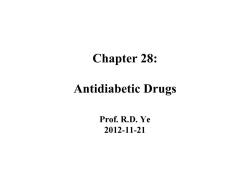
Chapter 28: Antidiabetic drugs Prof.R.D.Ye 2012-11-21
Chapter 28: Antidiabetic Drugs Prof. R.D. Ye 2012-11-21
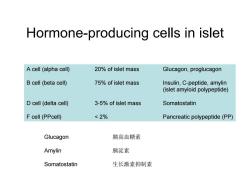
Hormone-producing cells in islet A cell (alpha cell) 20%of islet mass Glucagon,proglucagon B cell (beta cell) 75%of islet mass Insulin,C-peptide,amylin (islet amyloid polypeptide) D cell(delta cell) 3-5%of islet mass Somatostatin F cell (PPcell) <2% Pancreatic polypeptide(PP) Glucagon 胰高血糖素 Amylin 胰淀素 Somatostatin 生长激素抑制素
Hormone-producing cells in islet A cell (alpha cell) 20% of islet mass Glucagon, proglucagon B cell (beta cell) 75% of islet mass Insulin, C-peptide, amylin (islet amyloid polypeptide) D cell (delta cell) 3-5% of islet mass Somatostatin F cell (PPcell) < 2% Pancreatic polypeptide (PP) Glucagon 胰高血糖素 Amylin 胰淀素 Somatostatin 生长激素抑制素
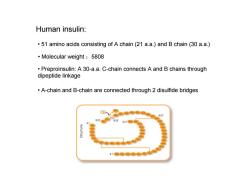
Human insulin: 51 amino acids consisting of A chain(21 a.a.)and B chain(30 a.a.) Molecular weight 5808 Preproinsulin:A 30-a.a.C-chain connects A and B chains through dipeptide linkage A-chain and B-chain are connected through 2 disulfide bridges B30 828 A1 Gly Ha 81@@@s@
Human insulin: • 51 amino acids consisting of A chain (21 a.a.) and B chain (30 a.a.) • Molecular weight :5808 • Preproinsulin: A 30-a.a. C-chain connects A and B chains through dipeptide linkage • A-chain and B-chain are connected through 2 disulfide bridges
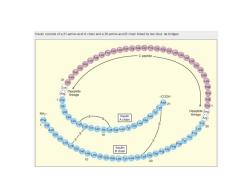
Insulin consists of a 21-amino-acid A chain and a 30-amino-acid B chain linked by two disul.de bridges. ooo0aaocodddaddde C peptide 31 GIn Arg Dipeptide linkage -COOH 1 Gly Asn 21 lle Cys NH2- Val Tyr Dipeptide(Arg lu Insulin linkage Phe A chain Glu g中e@8@w 00008e@0@80列0g66国ss586② GIn Thr s 30 10 Insulin Bchain 10 20
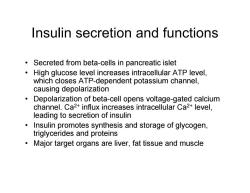
Insulin secretion and functions Secreted from beta-cells in pancreatic islet High glucose level increases intracellular ATP level, which closes ATP-dependent potassium channel, causing depolarization Depolarization of beta-cell opens voltage-gated calcium channel.Ca2+influx increases intracellular Ca2+level. leading to secretion of insulin Insulin promotes synthesis and storage of glycogen, triglycerides and proteins Major target organs are liver,fat tissue and muscle
Insulin secretion and functions • Secreted from beta-cells in pancreatic islet • High glucose level increases intracellular ATP level, which closes ATP-dependent potassium channel, causing depolarization • Depolarization of beta-cell opens voltage-gated calcium channel. Ca2+ influx increases intracellular Ca2+ level, leading to secretion of insulin • Insulin promotes synthesis and storage of glycogen, triglycerides and proteins • Major target organs are liver, fat tissue and muscle
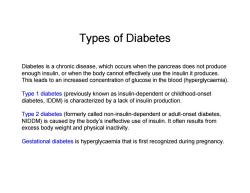
Types of Diabetes Diabetes is a chronic disease,which occurs when the pancreas does not produce enough insulin,or when the body cannot effectively use the insulin it produces. This leads to an increased concentration of glucose in the blood (hyperglycaemia) Type 1 diabetes(previously known as insulin-dependent or childhood-onset diabetes,IDDM)is characterized by a lack of insulin production. Type 2 diabetes(formerly called non-insulin-dependent or adult-onset diabetes, NIDDM)is caused by the body's ineffective use of insulin.It often results from excess body weight and physical inactivity. Gestational diabetes is hyperglycaemia that is first recognized during pregnancy
Diabetes is a chronic disease, which occurs when the pancreas does not produce enough insulin, or when the body cannot effectively use the insulin it produces. This leads to an increased concentration of glucose in the blood (hyperglycaemia). Type 1 diabetes (previously known as insulin-dependent or childhood-onset diabetes, IDDM) is characterized by a lack of insulin production. Type 2 diabetes (formerly called non-insulin-dependent or adult-onset diabetes, NIDDM) is caused by the body’s ineffective use of insulin. It often results from excess body weight and physical inactivity. Gestational diabetes is hyperglycaemia that is first recognized during pregnancy. Types of Diabetes
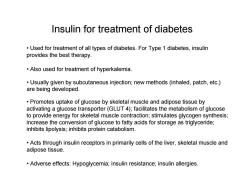
Insulin for treatment of diabetes Used for treatment of all types of diabetes.For Type 1 diabetes,insulin provides the best therapy. Also used for treatment of hyperkalemia. Usually given by subcutaneous injection;new methods(inhaled,patch,etc.) are being developed. Promotes uptake of glucose by skeletal muscle and adipose tissue by activating a glucose transporter(GLUT 4);facilitates the metabolism of glucose to provide energy for skeletal muscle contraction;stimulates glycogen synthesis; increase the conversion of glucose to fatty acids for storage as triglyceride; inhibits lipolysis;inhibits protein catabolism. Acts through insulin receptors in primarily cells of the liver,skeletal muscle and adipose tissue. Adverse effects:Hypoglycemia;insulin resistance;insulin allergies
Insulin for treatment of diabetes • Used for treatment of all types of diabetes. For Type 1 diabetes, insulin provides the best therapy. • Also used for treatment of hyperkalemia. • Usually given by subcutaneous injection; new methods (inhaled, patch, etc.) are being developed. • Promotes uptake of glucose by skeletal muscle and adipose tissue by activating a glucose transporter (GLUT 4); facilitates the metabolism of glucose to provide energy for skeletal muscle contraction; stimulates glycogen synthesis; increase the conversion of glucose to fatty acids for storage as triglyceride; inhibits lipolysis; inhibits protein catabolism. • Acts through insulin receptors in primarily cells of the liver, skeletal muscle and adipose tissue. • Adverse effects: Hypoglycemia; insulin resistance; insulin allergies
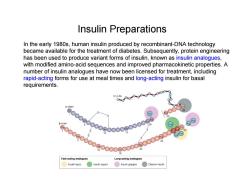
Insulin Preparations In the early 1980s,human insulin produced by recombinant-DNA technology became available for the treatment of diabetes.Subsequently,protein engineering has been used to produce variant forms of insulin,known as insulin analogues, with modified amino-acid sequences and improved pharmacokinetic properties.A number of insulin analogues have now been licensed for treatment,including rapid-acting forms for use at meal times and long-acting insulin for basal requirements. C14-FA a-chain 29 d00oooooooo00oooooo9 oooeobooeoooopoooopoooos β-chan 20 10 ©西 15 Fast-acting analogues Long-acting analogues Insuin lispro Insulin aspart Insuin glargine Detemirinsulin
In the early 1980s, human insulin produced by recombinant-DNA technology became available for the treatment of diabetes. Subsequently, protein engineering has been used to produce variant forms of insulin, known as insulin analogues, with modified amino-acid sequences and improved pharmacokinetic properties. A number of insulin analogues have now been licensed for treatment, including rapid-acting forms for use at meal times and long-acting insulin for basal requirements. Insulin Preparations
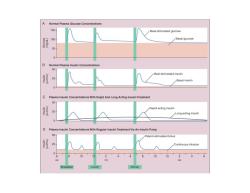
A Normal Plasma Glucose Concentrations 150 Meal-stimulated glucose 100 Basal glucose 50 0- B Normal Plasma Insulin Concentrations 50 Meal-stimulated insulin uinsu (wn) 25 Basal insulin C Plasma Insulin Concentrations With Rapid And Long Acting Insulin Treatment 50- Rapid-acting insulin Long-acting insulin 0 0 Plasma Insulin Concentrations With Regular Insulin Treatment Via An Insulin Pump 50- Patient-stimulated bolus 25 Continuous infusion 0 6 8 10 2 0 12 AM PM 多 Breakfast Lunch Dinner
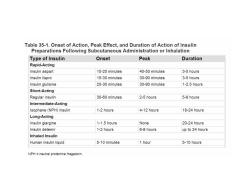
Table 35-1.Onset of Action,Peak Effect,and Duration of Action of Insulin Preparations Following Subcutaneous Administration or Inhalation Type of Insulin Onset Peak Duration Rapid-Acting Insulin aspart 10-20 minutes 40-50 minutes 3-5 hours Insulin lispro 15-30 minutes 30-90 minutes 3-5 hours Insulin glulisine 20-30 minutes 30-90 minutes 1-2.5 hours Short-Acting Regular insulin 30-60 minutes 2-5 hours 5-8 hours Intermediate-Acting Isophane (NPH)insulin 1-2 hours 4-12 hours 18-24 hours Long-Acting Insulin glargine 1-1.5 hours None 20-24 hours Insulin detemir 1-2 hours 6-8 hours up to 24 hours Inhaled Insulin Human insulin liquid 5-10 minutes 1 hour 5-10 hours NPH neutral protamine Hagedorn
按次数下载不扣除下载券;
注册用户24小时内重复下载只扣除一次;
顺序:VIP每日次数-->可用次数-->下载券;
- 上海交通大学:《药理学 Pharmacology》课程教学资源(讲义课件)Chapter 26:Drugs for Digestive Disorders.pdf
- 上海交通大学:《药理学 Pharmacology》课程教学资源(讲义课件)Chapter 24:Autacoid Drugs.pdf
- 上海交通大学:《药理学 Pharmacology》课程教学资源(讲义课件)Antipyretic-analgesic and anti-inflammatory drugs(nonsteroidal anti-inflammatory drugs,NSAIDs).pdf
- 上海交通大学:《药理学 Pharmacology》课程教学资源(讲义课件)Histamine &H-R blocking drugs.pdf
- 上海交通大学:《药理学 Pharmacology》课程教学资源(讲义课件)Drugs for the treatment of Parkinson's disease & Alzheimer's disease.pdf
- 上海交通大学:《药理学 Pharmacology》课程教学资源(讲义课件)Opioid Analgesics & drug abuse.pdf
- 上海交通大学:《药理学 Pharmacology》课程教学资源(讲义课件)Drugs for psychiatric disorders.pdf
- 上海交通大学:《药理学 Pharmacology》课程教学资源(讲义课件)General anesthetics(全身麻醉药)Anti-epileptics(抗癫痫药).pdf
- 上海交通大学:《药理学 Pharmacology》课程教学资源(讲义课件)Hypnotics & anxiolytics.pdf
- 上海交通大学:《药理学 Pharmacology》课程教学资源(讲义课件)Diuretics Excretion of Water and Electrolytes.pdf
- 上海交通大学:《药理学 Pharmacology》课程教学资源(讲义课件)Lipidemic modulating drugs Antiatherosclerotic agents.pdf
- 上海交通大学:《药理学 Pharmacology》课程教学资源(讲义课件)血液中使用的药剂 Agents used in blood.pdf
- 上海交通大学:《药理学 Pharmacology》课程教学资源(讲义课件)Drugs for Congestive Heart Failure.pdf
- 上海交通大学:《药理学 Pharmacology》课程教学资源(讲义课件)抗心律失常药物 Anti-Arrhythmic Drug.pdf
- 上海交通大学:《药理学 Pharmacology》课程教学资源(讲义课件)抗心绞痛药物 ANTIANGINAL DRUGS.pdf
- 上海交通大学:《药理学 Pharmacology》课程教学资源(讲义课件)Chapter 8:Antihypertensive Drugs.pdf
- 上海交通大学:《药理学 Pharmacology》课程教学资源(讲义课件)Chapter 5:Cholinergic Drugs.pdf
- 上海交通大学:《药理学 Pharmacology》课程教学资源(讲义课件)Chapter 6 Adrenoceptor drugs(agonists and antagonists).pdf
- 上海交通大学:《药理学 Pharmacology》课程教学资源(讲义课件)Chapter 4:Pharmacology of Peripheral Nervous System - Overview.pdf
- 上海交通大学:《药理学 Pharmacology》课程教学资源(讲义课件)Chapter 3:Receptor Theory and Pharmacodynamics(2).pdf
- 上海交通大学:《药理学 Pharmacology》课程教学资源(讲义课件)Chapter 29:Thyroid Drugs.pdf
- 上海交通大学:《药理学 Pharmacology》课程教学资源(讲义课件)性激素类药及避孕药 Sex Hormones and Contraceptives.pdf
- 上海交通大学:《药理学 Pharmacology》课程教学资源(讲义课件)Anti-bacterial drugs——general principles.pdf
- 上海交通大学:《药理学 Pharmacology》课程教学资源(讲义课件)β-lactams and other antibiotics acting upon cell wall.pdf
- 上海交通大学:《药理学 Pharmacology》课程教学资源(讲义课件)Aminoglycosides(氨基糖苷 类)and polymyxins 多粘菌素)Macrolides(大环内酯类)and other antibiotics.pdf
- 上海交通大学:《药理学 Pharmacology》课程教学资源(讲义课件)Anti-fungal drugs 抗真菌药.pdf
- 上海交通大学:《药理学 Pharmacology》课程教学资源(讲义课件)Antimycobacterial drugs(抗结核分枝杆菌药)and antileprotic drugs(抗麻风病药).pdf
- 上海交通大学:《药理学 Pharmacology》课程教学资源(讲义课件)Anti-parasitic drugs(抗寄生虫药).pdf
- 上海交通大学:《药理学 Pharmacology》课程教学资源(讲义课件)Antiviral drugs(抗病毒药).pdf
- 上海交通大学:《药理学 Pharmacology》课程教学资源(讲义课件)Cancer Chemotherapy 肿瘤化疗.pdf
- 上海交通大学:《药理学 Pharmacology》课程教学资源(讲义课件)Chapter 4 Overview of Peripheral Nervous System.pdf
- 上海交通大学:《药理学 Pharmacology》课程教学资源(讲义课件)Chapter 5 Cholinergic Drugs.pdf
- 上海交通大学:《药理学》课程教学资源(电子教案)第八章 抗高血压药.doc
- 上海交通大学:《药理学》课程教学资源(电子教案)第十章 抗心力衰竭药、第十一章 抗心律失常药.docx
- 上海交通大学:《药理学》课程教学资源(PPT课件)中枢概论麻醉 Drugs that act in the central nervous system(殷明).ppt
- 上海交通大学:《药理学》课程教学资源(PPT课件)镇静抗癫痫 Sedative-hypnotics.ppt
- 上海交通大学:《药理学》课程教学资源(PPT课件)抗精神失常药 Drugs for psychiatric disorders.ppt
- 上海交通大学:《药理学》课程教学资源(课程讲稿)Drugs for Congestive Heart Failure.pdf
- 上海交通大学:《药理学》课程教学资源(课程讲稿)抗心律失常药 Anti-Arrhythmic Drug.pdf
- 上海交通大学:《药理学》课程教学资源(课程讲稿)抗心绞痛药 ANTIANGINAL DRUGS.pdf
